- Home
- Ann M. Martin
Kristy Thomas, Dog Trainer Page 2
Kristy Thomas, Dog Trainer Read online
Page 2
Mary Anne and I are the other set of best friends in the BSC. Mary Anne is also short (but yes, taller than I am) with brown hair, pale skin, and brown eyes. She’s a fashion conservative, but she does not wear the same kind of clothes every day as I do.
Like me, Mary Anne is part of a blended family. Her mother died not long after Mary Anne was born, and Mary Anne can barely remember anything about her. Mr. Spier raised Mary Anne all alone, and he was a loving but very strict parent, because he didn’t want to make any mistakes. That was okay, until Mary Anne wanted to stop wearing pigtails every day and pick out her own clothes.
After a bit of a struggle, her father realized she was growing up and he relaxed a little. Then his old high school sweetheart, Sharon Schafer, who’d recently been divorced, moved back to Stoneybrook with her daughter and son.
Mary Anne became best friends with Dawn Schafer, who had transferred into SMS. (At first, I had a hard time admitting that my best friend could have two best friends. But Mary Anne and I sorted that out.) Dawn joined the BSC as an alternate officer. When Dawn’s mother and Mary Anne’s father were married (with a little help from Dawn and Mary Anne), Mary Anne and her father and Mary Anne’s kitten, Tigger, moved into Sharon and Dawn’s old farmhouse.
Mary Anne is almost painfully shy and sensitive — even touching commercials can make her cry. She’s not nearly as outgoing and outspoken as I am. Dawn is somewhere in between. She can be as stubborn as Mary Anne or me. She’s outspoken about what she believes in, such as recycling, vegetarianism, and being environmentally responsible.
Dawn is tall and thin and very blonde, with pale blue eyes and pierced ears, two holes in each ear. She’s not the sports fanatic that I am, but she’s an avid surfer (her skin tans easily and even catches a few freckles from the sun). Surfing was probably one of the reasons she missed California so much. In fact, both she and her younger brother ultimately made the very difficult decision to move back to California to live with their father.
That’s how Dawn became an honorary member of the BSC. She still visits often and we all stay in close touch. We’ve even been known to trade cross-country advice on baby-sitting.
Finding an alternate officer to replace Dawn wasn’t easy, until Abby, our newest member, moved to Stoneybrook from Long Island with her mother and her twin sister, Anna. Like me, Abby is outspoken (too outspoken sometimes — she even argues with me) and a sports fan. But she takes it a step further. She’s a soccer star and is always in training for something. (That afternoon, she’d come straight to the BSC meeting from a pick-up soccer game.) I don’t think she ever walks if she can jog. As Abby would tell you, she has fast feet and a fast mouth — her idea of a joke, just proving my point that she also has a weird sense of humor.
Abby has a soccer player’s compact build. She’s medium tall, with brown eyes and curly dark brown hair. She wears glasses or contacts, depending on her mood (and sports schedule). Like Stacey, Abby has to deal with health problems. In her case, they’re allergies and asthma. When Abby says, “Life makes me sneeze,” she’s not kidding. She has to carry a prescription inhaler with her at all times, in case she has an asthma attack. It’s sort of a little tube full of medicine that you breathe in. But Abby doesn’t let that slow her down. She lives at warp speed, which is one of the things that makes her a good baby-sitter. She hasn’t met a kid yet with whom she can’t keep pace.
Logan Bruno, one of our associate members, is the only male member of the BSC. He shares Abby’s and my love of sports. Logan is from Kentucky. He has a soft southern accent and he’s easygoing and a good listener, a valuable trait in anyone. (I appreciate qualities in other people that I myself don’t necessarily have). He’s also connected to the BSC in another way — he’s Mary Anne’s boyfriend.
Shannon Kilbourne is our other associate member. She doesn’t attend many BSC meetings because she’s already booked to the max. She goes to Stoneybrook Day School with her two younger sisters. She’s a member of the French Club, the Astronomy Club (where she’s the youngest member and the vice-president), the Honor Society, and the debate team. She also takes part in most of the school plays. She has blonde hair, blue eyes, and prefers a casual style of dress when she’s not in her school uniform.
And that’s the BSC — every regular member of which was looking at me now, waiting to hear my dog story.
I cleared my throat importantly.
“Watson wants to raise a guide dog puppy,” I began.
“A puppy,” said Mary Anne, clasping her hands together. “I love puppies.”
“What kind?” asked Abby.
“When?” asked Jessi.
“Is it for someone?” asked Mallory. “I mean, aren’t guide dogs the dogs that blind people use?”
Before I could answer any of their questions, the phone rang and we spent several minutes setting up baby-sitting appointments with clients. One of the clients was Mrs. Cooper, who wanted someone to sit for her two sons.
“Deb will be with me,” Mrs. Cooper added. After I hung up the phone, Abby said, “Ahhhhh. I get it. Deb Cooper. Is that what this guide dog thing is about?”
“She’s home now, isn’t she?” Claudia asked.
“Anna said that Shannon told her Deb isn’t back in school yet, though,” Abby added. (Abby’s sister, Anna, and Shannon have become good friends.)
“Deb’s the one who inspired Watson to think about raising a puppy,” I said. “But the puppy’s not for her, of course.” I went on to tell everyone about my conversation with Watson.
“We’re going to be interviewed on Wednesday,” I concluded. “If we pass, I guess we get a puppy.”
“We can help you with the puppy,” Mallory offered.
“Just tell us what to do,” Jessi volunteered.
Mary Anne said in a choked voice, “But it’ll be so hard to give up a puppy you’ve raised.”
“I know,” I replied quickly. It was something I didn’t want to think about. “But we haven’t gotten the puppy yet.”
“You will,” Stacey assured me. Then she held up her dues envelope. “Meanwhile, it’s Monday, and I think you know what that means. Payday.”
As we handed over our dues, Stacey said thoughtfully, “You know, one of the things that blind people have to learn is how to tell coins apart by feeling them.”
Instinctively, I closed my eyes, trying to identify the coins in my hand. The ridged edges meant it was a quarter, didn’t they? Or was that a nickel? A quarter, I guessed. Dimes are thinner and smaller than pennies, but was I holding a thin, small dime, or a penny? A dime, I guessed.
I opened my eyes and stared down at the change. I’d been right about the quarter, wrong about the dime. It was a penny.
And what about paper money? I would have no way to know what denomination it was. I’d have to trust others to be honest.
Suddenly, I didn’t like this game. And it was only a game for me. It wasn’t real.
Not like it was for Deb. I stared down at my fistful of change and realized that I couldn’t begin to imagine what Deb was going through.
We passed the dog test. It wasn’t easy. Not that we had to fill out a real test or anything (although I know Watson had to sign forms and things like that). I also found out that raising a guide dog puppy isn’t quite the same as raising a regular puppy like Shannon.
The test consisted of a visit from a staff member at the Guide Dog Foundation. Her title was Puppy Coordinator, and her name was Gillian, and she was really nice. I liked her the moment she walked into our house that Wednesday afternoon.
We sat in the den for most of the interview. Gillian was very direct and straightforward and let us know from the beginning that the rules for raising a guide dog puppy were in many ways different from the rules for raising a family pet.
“Your puppy is being trained to do an important job,” she explained. “It’s what she or he has been bred to do. If you don’t follow the rules for raising your guide dog puppy, then that puppy will have a
very hard time passing guide dog training and won’t be able to do the job she or he was bred to do.”
I glanced at Karen. Her blue eyes were big and intent behind her glasses. She raised her hand as if she were in school.
Gillian smiled at Karen. “You don’t have to raise your hand, Karen. Do you have a question?”
Nodding and lowering her hand, Karen asked, “But what happens if a puppy fails its training? What happens to the puppy?”
“That’s a good question. Sometimes the dogs go to work for the police department, or even the customs agency, to be trained to work for them. But if they haven’t got the right personalities for that kind of work, the dogs can go back to live with their puppy trainer families. That happens sometimes.”
“Oh,” said Karen. She looked relieved.
Gillian met all the pets in our family. She laughed when Boo-Boo hissed at her. “Your puppy will learn to respect cats, I see that.” She nodded in approval at our yard, which is surrounded by an invisible electronic fence. “That’s something that every responsible dog owner should have. It’s criminal, in my opinion, to tie up a dog in the backyard, or worse, let it roam loose.” Gillian told us then that our puppy couldn’t just be let out into the backyard to relieve herself. Instead, the puppy would have to be taught to go on the pavement, on leash, on the command “Get busy,” because that is the command that would be given by the blind person with whom the puppy would one day work.
Gillian squatted down to pet Shannon. “What a good girl,” she said, laughing, as Shannon licked Gillian’s chin and wagged her tail furiously.
As she petted Shannon, Gillian reminded us that our puppy couldn’t sleep in the same place as Shannon, or play too much with her, or become too attached to her. “Your puppy has to be people-oriented, because that is who she is going to spend her life with. She can’t see another dog and think of it as an opportunity to play. That could be disastrous for her person.”
Watson explained that he would be the person primarily responsible for the puppy. “I’ll keep a crate in my home office,” he said. “As well as by my side of the bed.” (When our puppy became a guide dog, she — or he — would sleep next to her person’s bed.
There were other rules too. The puppy could chew on balls, but she could never learn to chase them, for the same reason that she couldn’t think of every other dog she met as a playmate. She couldn’t be fed from the table either, which wasn’t a problem. Watson and Mom have been strict about not feeding pets from the table. Mom says it isn’t right to teach a dog bad manners and then blame the dog for behaving badly.
And, of course, when a guide dog goes into a restaurant, it can’t expect to get a handout from the table!
Those were just a few of the rules. Raising a guide dog puppy was going to be even harder than I had realized. But the more I learned about it, the more I wanted to do it.
But would we pass the test?
At the end of the interview, Gillian shook hands with everybody, even Emily Michelle. “I can see a guide dog puppy will get lots of good experience living with your family,” she said to Watson.
“Does that mean we get the job?” Watson asked with a slow smile.
Gillian nodded. “I think you do.”
“Hooray!” David Michael shouted, which made Shannon bark.
“When do we get the puppy?” Karen asked eagerly.
Gillian’s answer took me by surprise. “We have a puppy ready right now. The couple who was going to raise her moved unexpectedly to another country. So the puppy came back to us. She’s just turned four months old and her name is Scout. You can come get her this Saturday morning.”
This weekend! Good grief! That was soon!
In a matter of days, we were going to have a new puppy in the house.
* * *
The Guide Dog Foundation is in Smithtown, Long Island, in New York, not far from where Abby used to live. From the front we saw what looked like a small, neat, square building behind a low white fence. I don’t know what I expected, but I liked how friendly it looked.
We saw six new Labrador retriever puppies in the glassed-in puppy nursery area. We also saw about a hundred dogs, black and yellow Labradors, golden retrievers, and a few Shiloh shepherds, which looked like German shepherds to me. Some were in training. Some were being boarded for their owners or puppy walker families.
All of them greeted us by barking loudly and wagging their tails.
Behind the foundation are dorms, where people stay when they come to get their guide dogs and learn how to work with them. I wondered if they could hear the barking in their dorms, and if they could tell the sound of one dog’s bark from another.
The dogs’ name plates were on their kennel-run doors, along with the names of their sponsors. I loved Scout’s name, in part because the narrator of one of my favorite books, To Kill a Mockingbird, is named Scout.
I couldn’t help but think, the moment I saw Scout, that she was extra-special. She was a beautiful chocolate-colored Labrador retriever. I fell in love with her instantly.
We went through a training session and saw a video about guide dogs and how to be a good puppy walker. Then Gillian gave us the foundation handbook with all the basic information on raising Scout. She went over it with us, patiently answering all our questions. Both Mom and Watson took careful notes.
Scout came with her own collar, special ID tags, and leash. We also got two bowls, a starter bag of the kind of dog food we were supposed to feed her, a crate for her to sleep in, and two Nylabones for her to chew. We were also given a yellow coat for her to wear that identified her as a guide dog puppy in training so that she could be taken everywhere (just as she would be when she became a working guide dog). Oh yes, we got her medical records too, and forms we were supposed to fill out in order to keep track of her progress for the Guide Dog Foundation, with which we would be in touch at least once a month.
After Watson filled out some more forms, we put Scout in her crate (which was basically a big cage) and put the crate in the car. Scout looked a little anxious, but mostly calm. Karen and David Michael sat on either side of her.
Karen petted the kennel. “Don’t worry, Scout,” she said. “We’re going to do everything just right. You’re going to have the best puppy walker family in the whole wide world.”
I hoped she was right.
Abby just happened to be jogging by when we got home with Scout. Claudia and Shannon weren’t even subtle about it. The moment we pulled up to the house, they walked out Shannon’s front door and across the street.
Although Scout was a calm puppy, she was still wiggly and adorable and irresistible. Claudia melted instantly, falling on her knees and saying, “Oh, you are so-o-o-o-o cute.” Shannon, meanwhile, was also kneeling next to Scout, talking baby talk.
Abby sneezed and said in a slightly thickened voice, “So you’re Scout. Hello, girl.” (I’d naturally kept the BSC members posted on every detail).
Scout wriggled her body enthusiastically.
Mom smiled. “I’ll go get Shannon,” she said. She was referring to Shannon our puppy. It was time for Shannon and Scout to meet. Even though Scout wouldn’t be able to play with Shannon, it was important to make them comfortable around each other. Thanks to Shannon and Mallory, I’d read many books, including two by dog trainers at a monastery, the Monks of New Skete, which Shannon had lent me, plus another one supplied by Mallory, written by a dog trainer named Carol Lea Benjamin, who was also a children’s book writer. In all the books we’d read, we’d been told that this was the best way for a dog to meet a new dog coming into its house — on neutral territory.
According to the books, dogs are pack animals and every one of them behaves according to certain universal rules. The families the dogs live with become their packs. Just like in a real pack, dogs don’t want newcomers in their packs without their permission.
Shannon came bounding out of the house and stopped when she saw Scout. Shannon’s ears went up. Then she mov
ed toward Scout. Shannon’s tail was wagging a little (which is sometimes a sign of being uncertain about how to react to a situation, according to the dog books).
The moment Shannon got close to Scout, Scout said, “You’re the boss! I’m friendly! Don’t hurt me!”
How did she say that? In dog language, of course. Dogs use a lot of body language. Dog language for “You’re the boss” is this: Scout rolled over on her back and put her paws in the air. Shannon sniffed Scout all over. Then she backed up slightly, put her front paws out in front of her in a dog bow, and said, “Woof!”
That’s dog language for “Let’s play!”
In an instant, Scout had rolled over, leaped up, and accepted the invitation. We let them spend time together for a few minutes and then we took them into the house.
“When do you start training her?” Abby asked.
“Right away,” I said.
Claudia looked doubtful. “Isn’t that awfully young? I mean, if puppies are like really little kids, they have about a two-second attention span.”
“You’re right about that, Claudia,” Watson agreed. “We won’t start out trying to teach her anything except how to be house-trained and how to get used to a leash and collar.”
“But we’re going to take her to puppy obedience classes right away,” I said. “It helps her to get used to other dogs and new situations and teaches us how to start training her.”
“Special classes for guide dogs?” Shannon asked. She was on the floor, scratching Scout’s soft ears.
“They have classes we can go to at the foundation,” I said. “But it’s a long drive, so we’ll probably go around here. We’re only supposed to teach Scout basic obedience commands like ‘sit’ and ‘stay.’ You know, good manners for dogs. She’ll learn the special guide dog stuff when she goes back to the foundation.”
“This is so cool,” said Abby. Then she sneezed again and added hastily, “Well, nice to meet you, Scout. I’d better get going.”

 Karen's Tea Party
Karen's Tea Party Kristy and the Snobs
Kristy and the Snobs Best Kept Secret
Best Kept Secret Karen's Kittens
Karen's Kittens Karen's Big Job
Karen's Big Job Claudia and the Genius of Elm Street
Claudia and the Genius of Elm Street The Fire at Mary Anne's House
The Fire at Mary Anne's House Science Fair
Science Fair Me and Katie (The Pest)
Me and Katie (The Pest) Karen's Plane Trip
Karen's Plane Trip Jessi's Wish
Jessi's Wish Dawn and Too Many Sitters
Dawn and Too Many Sitters Jessi and the Jewel Thieves
Jessi and the Jewel Thieves Eleven Kids, One Summer
Eleven Kids, One Summer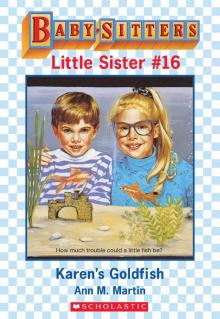 Karen's Goldfish
Karen's Goldfish Snow War
Snow War Abby and the Secret Society
Abby and the Secret Society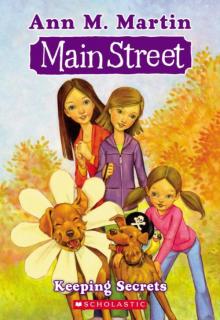 Keeping Secrets
Keeping Secrets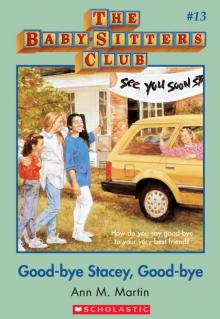 Good-Bye Stacey, Good-Bye
Good-Bye Stacey, Good-Bye Karen's Sleepover
Karen's Sleepover Claudia and the World's Cutest Baby
Claudia and the World's Cutest Baby Mary Anne Saves the Day
Mary Anne Saves the Day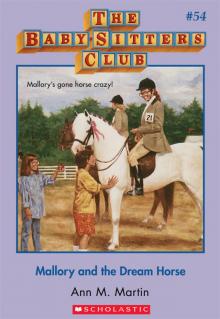 Mallory and the Dream Horse
Mallory and the Dream Horse Kristy and the Mystery Train
Kristy and the Mystery Train Dawn's Family Feud
Dawn's Family Feud Karen's Twin
Karen's Twin Little Miss Stoneybrook... And Dawn
Little Miss Stoneybrook... And Dawn Karen's Mistake
Karen's Mistake Karen's Movie Star
Karen's Movie Star Mallory and the Mystery Diary
Mallory and the Mystery Diary Karen's Monsters
Karen's Monsters Kristy + Bart = ?
Kristy + Bart = ? Karen's Dinosaur
Karen's Dinosaur Here Today
Here Today Karen's Carnival
Karen's Carnival How to Look for a Lost Dog
How to Look for a Lost Dog Stacey vs. Claudia
Stacey vs. Claudia Stacey's Ex-Boyfriend
Stacey's Ex-Boyfriend Here Come the Bridesmaids!
Here Come the Bridesmaids!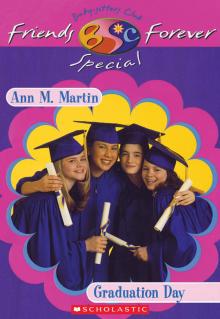 Graduation Day
Graduation Day Kristy's Big News
Kristy's Big News Karen's School Surprise
Karen's School Surprise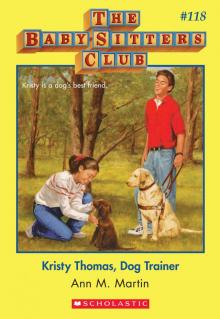 Kristy Thomas, Dog Trainer
Kristy Thomas, Dog Trainer Baby-Sitters' Christmas Chiller
Baby-Sitters' Christmas Chiller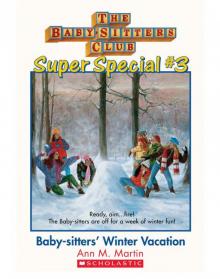 Baby-Sitters' Winter Vacation
Baby-Sitters' Winter Vacation Ten Good and Bad Things About My Life
Ten Good and Bad Things About My Life Claudia and the Bad Joke
Claudia and the Bad Joke Mary Anne's Makeover
Mary Anne's Makeover Stacey and the Fashion Victim
Stacey and the Fashion Victim Dawn Schafer, Undercover Baby-Sitter
Dawn Schafer, Undercover Baby-Sitter Karen's Tuba
Karen's Tuba Dawn's Wicked Stepsister
Dawn's Wicked Stepsister Diary Three: Dawn, Sunny, Maggie, Amalia, and Ducky
Diary Three: Dawn, Sunny, Maggie, Amalia, and Ducky Karen's Nanny
Karen's Nanny Jessi and the Awful Secret
Jessi and the Awful Secret Karen's New Year
Karen's New Year Karen's Candy
Karen's Candy Karen's President
Karen's President Mary Anne and the Great Romance
Mary Anne and the Great Romance Mary Anne + 2 Many Babies
Mary Anne + 2 Many Babies Kristy and the Copycat
Kristy and the Copycat Jessi and the Bad Baby-Sitter
Jessi and the Bad Baby-Sitter Claudia, Queen of the Seventh Grade
Claudia, Queen of the Seventh Grade Claudia and the Lighthouse Ghost
Claudia and the Lighthouse Ghost Karen's New Puppy
Karen's New Puppy Karen's Home Run
Karen's Home Run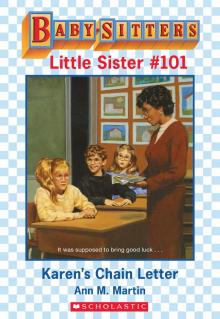 Karen's Chain Letter
Karen's Chain Letter Kristy in Charge
Kristy in Charge Karen's Angel
Karen's Angel Mary Anne and Too Many Boys
Mary Anne and Too Many Boys Karen's Big Fight
Karen's Big Fight Karen's Spy Mystery
Karen's Spy Mystery Stacey's Big Crush
Stacey's Big Crush Karen's School
Karen's School Claudia and the Terrible Truth
Claudia and the Terrible Truth Karen's Cowboy
Karen's Cowboy The Summer Before
The Summer Before Beware, Dawn!
Beware, Dawn! Belle Teale
Belle Teale Claudia's Big Party
Claudia's Big Party The Secret Life of Mary Anne Spier
The Secret Life of Mary Anne Spier Karen's Book
Karen's Book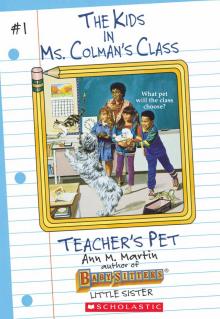 Teacher's Pet
Teacher's Pet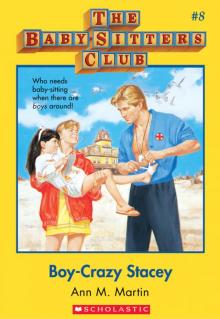 Boy-Crazy Stacey
Boy-Crazy Stacey Claudia and the Disaster Date
Claudia and the Disaster Date Author Day
Author Day Claudia and the Sad Good-Bye
Claudia and the Sad Good-Bye Kristy and the Worst Kid Ever
Kristy and the Worst Kid Ever Yours Turly, Shirley
Yours Turly, Shirley Class Play
Class Play Kristy and the Vampires
Kristy and the Vampires Kristy and the Cat Burglar
Kristy and the Cat Burglar Karen's Pumpkin Patch
Karen's Pumpkin Patch Stacey and the Mystery at the Empty House
Stacey and the Mystery at the Empty House Karen's Chicken Pox
Karen's Chicken Pox Mary Anne and the Playground Fight
Mary Anne and the Playground Fight Stacey's Mistake
Stacey's Mistake Coming Apart
Coming Apart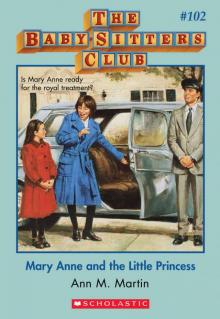 Mary Anne and the Little Princess
Mary Anne and the Little Princess Karen, Hannie and Nancy: The Three Musketeers
Karen, Hannie and Nancy: The Three Musketeers 'Tis the Season
'Tis the Season Claudia and Mean Janine
Claudia and Mean Janine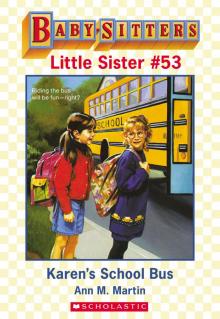 Karen's School Bus
Karen's School Bus Mary Anne's Big Breakup
Mary Anne's Big Breakup Rain Reign
Rain Reign Claudia and the Mystery at the Museum
Claudia and the Mystery at the Museum Claudia and the Great Search
Claudia and the Great Search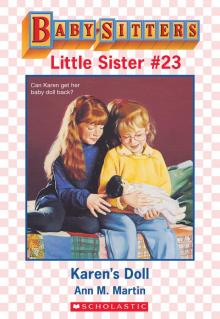 Karen's Doll
Karen's Doll Shannon's Story
Shannon's Story Sea City, Here We Come!
Sea City, Here We Come! Stacey and the Mystery of Stoneybrook
Stacey and the Mystery of Stoneybrook Karen's Treasure
Karen's Treasure Ten Rules for Living With My Sister
Ten Rules for Living With My Sister With You and Without You
With You and Without You Baby-Sitters' Island Adventure
Baby-Sitters' Island Adventure Karen's Fishing Trip
Karen's Fishing Trip Dawn and the Big Sleepover
Dawn and the Big Sleepover New York, New York!
New York, New York! Ten Kids, No Pets
Ten Kids, No Pets Happy Holidays, Jessi
Happy Holidays, Jessi Halloween Parade
Halloween Parade Karen's New Holiday
Karen's New Holiday Kristy Power!
Kristy Power! Karen's Wish
Karen's Wish Claudia and the Mystery in the Painting
Claudia and the Mystery in the Painting Karen's Stepmother
Karen's Stepmother Abby in Wonderland
Abby in Wonderland Karen's Snow Day
Karen's Snow Day Kristy and the Secret of Susan
Kristy and the Secret of Susan Karen's Pony Camp
Karen's Pony Camp Karen's School Trip
Karen's School Trip Mary Anne to the Rescue
Mary Anne to the Rescue Karen's Unicorn
Karen's Unicorn Abby and the Notorious Neighbor
Abby and the Notorious Neighbor Stacey and the Haunted Masquerade
Stacey and the Haunted Masquerade Claudia Gets Her Guy
Claudia Gets Her Guy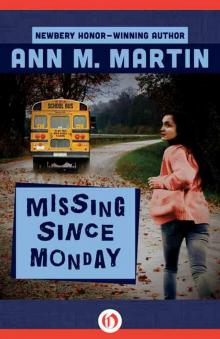 Missing Since Monday
Missing Since Monday Stacey's Choice
Stacey's Choice Stacey's Ex-Best Friend
Stacey's Ex-Best Friend Karen's New Teacher
Karen's New Teacher Karen's Accident
Karen's Accident Karen's Lucky Penny
Karen's Lucky Penny Karen's Cartwheel
Karen's Cartwheel Karen's Puppet Show
Karen's Puppet Show Spelling Bee
Spelling Bee Stacey's Problem
Stacey's Problem Stacey and the Stolen Hearts
Stacey and the Stolen Hearts Karen's Surprise
Karen's Surprise Karen's Worst Day
Karen's Worst Day The Ghost at Dawn's House
The Ghost at Dawn's House Karen's Big Sister
Karen's Big Sister Karen's Easter Parade
Karen's Easter Parade Mary Anne and the Silent Witness
Mary Anne and the Silent Witness Karen's Swim Meet
Karen's Swim Meet Mary Anne's Revenge
Mary Anne's Revenge Karen's Mystery
Karen's Mystery Stacey and the Mystery Money
Stacey and the Mystery Money Dawn and the Disappearing Dogs
Dawn and the Disappearing Dogs Karen's Christmas Tree
Karen's Christmas Tree Welcome to Camden Falls
Welcome to Camden Falls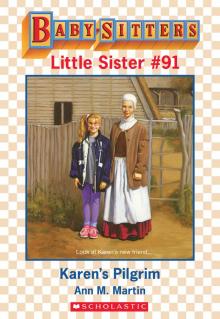 Karen's Pilgrim
Karen's Pilgrim Dawn and the Halloween Mystery
Dawn and the Halloween Mystery Mary Anne in the Middle
Mary Anne in the Middle Karen's Toys
Karen's Toys Kristy's Great Idea
Kristy's Great Idea Claudia and the Middle School Mystery
Claudia and the Middle School Mystery Karen's Big Weekend
Karen's Big Weekend Logan's Story
Logan's Story Karen's Yo-Yo
Karen's Yo-Yo Kristy's Book
Kristy's Book Mallory and the Ghost Cat
Mallory and the Ghost Cat Mary Anne and the Music
Mary Anne and the Music Karen's Tattletale
Karen's Tattletale Karen's County Fair
Karen's County Fair Karen's Mermaid
Karen's Mermaid Snowbound
Snowbound Karen's Movie
Karen's Movie Jessi and the Troublemaker
Jessi and the Troublemaker Baby-Sitters at Shadow Lake
Baby-Sitters at Shadow Lake Mallory on Strike
Mallory on Strike Jessi's Baby-Sitter
Jessi's Baby-Sitter Karen's Leprechaun
Karen's Leprechaun Claudia and the Phantom Phone Calls
Claudia and the Phantom Phone Calls Karen's Good-Bye
Karen's Good-Bye Karen's Figure Eight
Karen's Figure Eight Logan Likes Mary Anne!
Logan Likes Mary Anne! Mary Anne and the Zoo Mystery
Mary Anne and the Zoo Mystery Missy Piggle-Wiggle and the Whatever Cure
Missy Piggle-Wiggle and the Whatever Cure Dawn on the Coast
Dawn on the Coast Stacey and the Cheerleaders
Stacey and the Cheerleaders Claudia and the Clue in the Photograph
Claudia and the Clue in the Photograph Karen's New Friend
Karen's New Friend Mallory and the Trouble With Twins
Mallory and the Trouble With Twins Karen's Roller Skates
Karen's Roller Skates Abby and the Best Kid Ever
Abby and the Best Kid Ever Poor Mallory!
Poor Mallory! Karen's Witch
Karen's Witch Karen's Grandmothers
Karen's Grandmothers Slam Book
Slam Book Karen's School Picture
Karen's School Picture Karen's Reindeer
Karen's Reindeer Kristy's Big Day
Kristy's Big Day The Long Way Home
The Long Way Home Karen's Sleigh Ride
Karen's Sleigh Ride On Christmas Eve
On Christmas Eve Karen's Copycat
Karen's Copycat Karen's Ice Skates
Karen's Ice Skates Claudia and the Little Liar
Claudia and the Little Liar Abby the Bad Sport
Abby the Bad Sport The Baby-Sitters Club #5: Dawn and the Impossible Three
The Baby-Sitters Club #5: Dawn and the Impossible Three Abby's Book
Abby's Book Karen's Big Top
Karen's Big Top Main Street #8: Special Delivery
Main Street #8: Special Delivery Kristy and the Kidnapper
Kristy and the Kidnapper Karen's Ski Trip
Karen's Ski Trip Karen's Hurricane
Karen's Hurricane Stacey and the Mystery at the Mall
Stacey and the Mystery at the Mall Jessi and the Superbrat
Jessi and the Superbrat Kristy and the Baby Parade
Kristy and the Baby Parade Karen's New Bike
Karen's New Bike Karen's Big City Mystery
Karen's Big City Mystery Baby-Sitters' European Vacation
Baby-Sitters' European Vacation Hello, Mallory
Hello, Mallory Dawn's Big Date
Dawn's Big Date Karen's Christmas Carol
Karen's Christmas Carol Jessi's Horrible Prank
Jessi's Horrible Prank Kristy and the Missing Fortune
Kristy and the Missing Fortune Kristy and the Haunted Mansion
Kristy and the Haunted Mansion Jessi's Big Break
Jessi's Big Break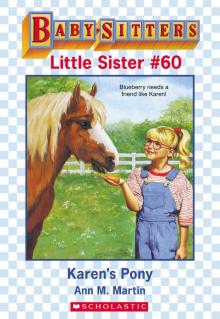 Karen's Pony
Karen's Pony Welcome Home, Mary Anne
Welcome Home, Mary Anne Stacey the Math Whiz
Stacey the Math Whiz September Surprises
September Surprises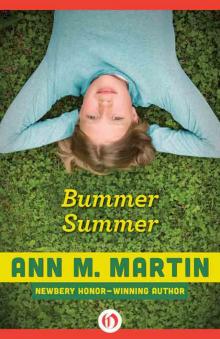 Bummer Summer
Bummer Summer Karen's Secret
Karen's Secret Abby's Twin
Abby's Twin Main Street #4: Best Friends
Main Street #4: Best Friends Karen's Big Move
Karen's Big Move Mary Anne Misses Logan
Mary Anne Misses Logan Stacey's Book
Stacey's Book Claudia and the Perfect Boy
Claudia and the Perfect Boy Holiday Time
Holiday Time Stacey's Broken Heart
Stacey's Broken Heart Karen's Field Day
Karen's Field Day Kristy's Worst Idea
Kristy's Worst Idea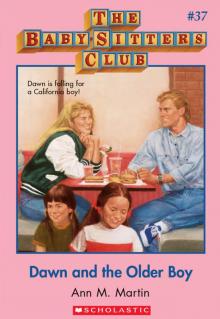 Dawn and the Older Boy
Dawn and the Older Boy Karen's Brothers
Karen's Brothers Claudia's Friend
Claudia's Friend Mary Anne and the Haunted Bookstore
Mary Anne and the Haunted Bookstore Dawn and Whitney, Friends Forever
Dawn and Whitney, Friends Forever Summer School
Summer School Karen's Birthday
Karen's Birthday Karen's Black Cat
Karen's Black Cat Stacey McGill... Matchmaker?
Stacey McGill... Matchmaker? Claudia's Book
Claudia's Book Main Street #2: Needle and Thread
Main Street #2: Needle and Thread Karen's Runaway Turkey
Karen's Runaway Turkey Karen's Campout
Karen's Campout Karen's Bunny
Karen's Bunny Claudia and the New Girl
Claudia and the New Girl Karen's Wedding
Karen's Wedding Karen's Promise
Karen's Promise Karen's Snow Princess
Karen's Snow Princess Claudia Kishi, Middle School Dropout
Claudia Kishi, Middle School Dropout Starring the Baby-Sitters Club!
Starring the Baby-Sitters Club! Kristy for President
Kristy for President California Girls!
California Girls! Maid Mary Anne
Maid Mary Anne Abby's Un-Valentine
Abby's Un-Valentine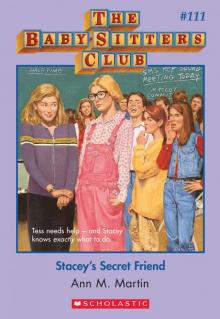 Stacey's Secret Friend
Stacey's Secret Friend Karen's Haunted House
Karen's Haunted House Claudia and Crazy Peaches
Claudia and Crazy Peaches Karen's Prize
Karen's Prize Get Well Soon, Mallory!
Get Well Soon, Mallory! Karen's Doll Hospital
Karen's Doll Hospital Karen's Newspaper
Karen's Newspaper Karen's Toothache
Karen's Toothache Mary Anne and Miss Priss
Mary Anne and Miss Priss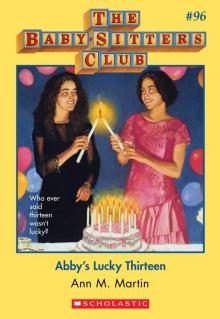 Abby's Lucky Thirteen
Abby's Lucky Thirteen The Secret Book Club
The Secret Book Club The All-New Mallory Pike
The All-New Mallory Pike Karen's Turkey Day
Karen's Turkey Day Karen's Magician
Karen's Magician Mary Anne and the Library Mystery
Mary Anne and the Library Mystery Diary One: Dawn, Sunny, Maggie, Amalia, and Ducky
Diary One: Dawn, Sunny, Maggie, Amalia, and Ducky Mary Anne and the Secret in the Attic
Mary Anne and the Secret in the Attic Kristy and the Mother's Day Surprise
Kristy and the Mother's Day Surprise Karen's in Love
Karen's in Love Welcome to the BSC, Abby
Welcome to the BSC, Abby Karen's Kittycat Club
Karen's Kittycat Club The Mystery at Claudia's House
The Mystery at Claudia's House The Truth About Stacey
The Truth About Stacey Karen's Bully
Karen's Bully Karen's Gift
Karen's Gift BSC in the USA
BSC in the USA Everything for a Dog
Everything for a Dog Dawn and the We Love Kids Club
Dawn and the We Love Kids Club Karen's Ghost
Karen's Ghost Stacey's Lie
Stacey's Lie Jessi's Secret Language
Jessi's Secret Language Kristy and the Missing Child
Kristy and the Missing Child Better to Wish
Better to Wish Baby-Sitters on Board!
Baby-Sitters on Board! Kristy at Bat
Kristy at Bat Everything Changes
Everything Changes Don't Give Up, Mallory
Don't Give Up, Mallory A Dog's Life: The Autobiography of a Stray
A Dog's Life: The Autobiography of a Stray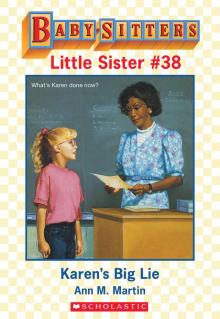 Karen's Big Lie
Karen's Big Lie Karen's Show and Share
Karen's Show and Share Mallory Hates Boys (and Gym)
Mallory Hates Boys (and Gym) Diary Two: Dawn, Sunny, Maggie, Amalia, and Ducky
Diary Two: Dawn, Sunny, Maggie, Amalia, and Ducky Karen's Pen Pal
Karen's Pen Pal Claudia and the Friendship Feud
Claudia and the Friendship Feud Karen's Secret Valentine
Karen's Secret Valentine Keep Out, Claudia!
Keep Out, Claudia! Aloha, Baby-Sitters!
Aloha, Baby-Sitters! Welcome Back, Stacey
Welcome Back, Stacey Jessi Ramsey, Pet-Sitter
Jessi Ramsey, Pet-Sitter Karen's Pizza Party
Karen's Pizza Party Kristy and the Dirty Diapers
Kristy and the Dirty Diapers Staying Together
Staying Together Dawn and the Surfer Ghost
Dawn and the Surfer Ghost Claudia Makes Up Her Mind
Claudia Makes Up Her Mind Jessi's Gold Medal
Jessi's Gold Medal Karen's Kite
Karen's Kite Baby Animal Zoo
Baby Animal Zoo Dawn's Big Move
Dawn's Big Move Karen's Big Joke
Karen's Big Joke Karen's Lemonade Stand
Karen's Lemonade Stand Ma and Pa Dracula
Ma and Pa Dracula Baby-Sitters' Haunted House
Baby-Sitters' Haunted House Abby and the Mystery Baby
Abby and the Mystery Baby Home Is the Place
Home Is the Place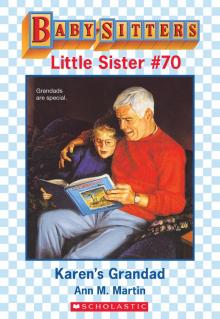 Karen's Grandad
Karen's Grandad Twin Trouble
Twin Trouble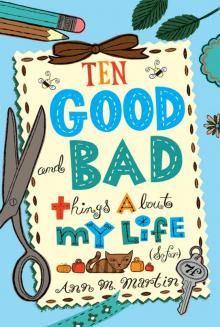 Ten Good and Bad Things About My Life (So Far)
Ten Good and Bad Things About My Life (So Far) Diary Two
Diary Two Baby-Sitters Club 027
Baby-Sitters Club 027 Claudia and the Mystery Painting
Claudia and the Mystery Painting Diary One
Diary One Baby-Sitters Club 037
Baby-Sitters Club 037 Baby-Sitters Club 028
Baby-Sitters Club 028 Baby-Sitters Club 085
Baby-Sitters Club 085 Dawn Schaffer Undercover Baby-Sitter
Dawn Schaffer Undercover Baby-Sitter Jessi's Babysitter
Jessi's Babysitter The Baby-Sitters Club #110: Abby the Bad Sport (Baby-Sitters Club, The)
The Baby-Sitters Club #110: Abby the Bad Sport (Baby-Sitters Club, The) Karen's Little Sister
Karen's Little Sister Baby-Sitters Club 058
Baby-Sitters Club 058 Claudia And The Genius On Elm St.
Claudia And The Genius On Elm St. Missy Piggle-Wiggle and the Sticky-Fingers Cure
Missy Piggle-Wiggle and the Sticky-Fingers Cure Kristy and Kidnapper
Kristy and Kidnapper Baby-Sitters Club 041
Baby-Sitters Club 041 Karen's Bunny Trouble
Karen's Bunny Trouble Baby-Sitters Club 032
Baby-Sitters Club 032 Diary Three
Diary Three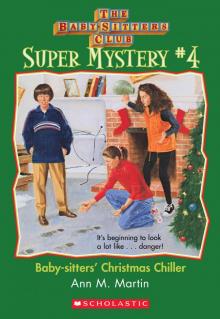 Christmas Chiller
Christmas Chiller Karen's Half-Birthday
Karen's Half-Birthday Needle and Thread
Needle and Thread Secret Life of Mary Anne Spier
Secret Life of Mary Anne Spier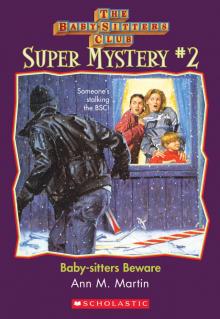 Baby-Sitters Beware
Baby-Sitters Beware Claudia Kishi, Middle School Drop-Out
Claudia Kishi, Middle School Drop-Out Logan Likes Mary Anne !
Logan Likes Mary Anne ! Baby-Sitters Club 061
Baby-Sitters Club 061 Best Friends
Best Friends Baby-Sitters Club 031
Baby-Sitters Club 031 Karen's Little Witch
Karen's Little Witch Jessi Ramsey, Petsitter
Jessi Ramsey, Petsitter Baby-Sitters Club 123
Baby-Sitters Club 123 Baby-Sitters Club 059
Baby-Sitters Club 059 Baby-Sitters Club 033
Baby-Sitters Club 033 Baby-Sitters Club 060
Baby-Sitters Club 060 Baby-Sitters Club 094
Baby-Sitters Club 094 The Baby-Sitters Club #99: Stacey's Broken Heart
The Baby-Sitters Club #99: Stacey's Broken Heart The Baby-Sitters Club #109: Mary Anne to the Rescue (Baby-Sitters Club, The)
The Baby-Sitters Club #109: Mary Anne to the Rescue (Baby-Sitters Club, The) Mystery At Claudia's House
Mystery At Claudia's House Claudia And The Sad Goodbye
Claudia And The Sad Goodbye Mary Anne's Big Break-Up
Mary Anne's Big Break-Up Baby-Sitters Club 025
Baby-Sitters Club 025 Baby-Sitters Club 042
Baby-Sitters Club 042 Stacey and the Mystery of the Empty House
Stacey and the Mystery of the Empty House Karen's Baby-Sitter
Karen's Baby-Sitter Claudia's Friendship Feud
Claudia's Friendship Feud Baby-Sitters Club 090
Baby-Sitters Club 090 Baby-Sitters Club 021
Baby-Sitters Club 021 Baby-Sitters Club 056
Baby-Sitters Club 056 Baby-Sitters Club 040
Baby-Sitters Club 040 The Baby-Sitters Club #108: Don't Give Up, Mallory (Baby-Sitters Club, The)
The Baby-Sitters Club #108: Don't Give Up, Mallory (Baby-Sitters Club, The) Dawn and the Impossible Three
Dawn and the Impossible Three The Snow War
The Snow War Special Delivery
Special Delivery Baby-Sitters Club 057
Baby-Sitters Club 057 Mary Anne And Too Many Babies
Mary Anne And Too Many Babies Baby-Sitters Club 030
Baby-Sitters Club 030